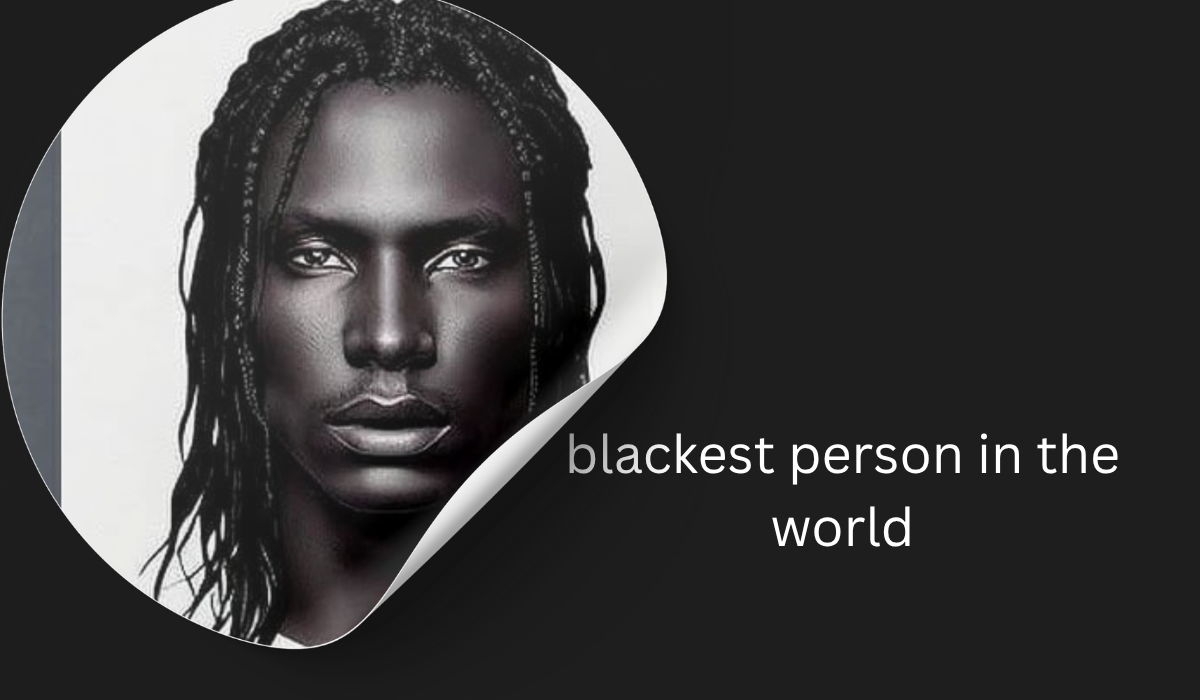An exploration of the world’s deepest skin tones, moving beyond a simple record to uncover the science, culture, and beauty of human pigmentation
When we hear a phrase like “the blackest person in the world,” it often conjures a mental image of a singular, record-holding individual, a person whose skin tone exists at the furthest extreme of human possibility. It’s a concept that taps into our fascination with superlatives—the tallest, the fastest, the richest. But the true story of skin color, particularly the deepest, richest ebony hues, is far more complex, beautiful, and scientifically fascinating than a simple competition. It’s a narrative woven from ancient genetics, profound cultural significance, and a deep-seated human history written in melanin.
This article isn’t about crowning one person. Instead, it’s an exploration of what it means to possess skin with such profound depth of color, the science that creates it, the cultural perceptions that surround it, and the living, breathing diversity of the people who embody this magnificent aspect of human variation.
The Science of the Shade: More Than Just Melanin
To understand the deepest skin tones, we must first move beyond the simplistic idea of “black” or “white” skin. Every human on the planet, regardless of shade, has roughly the same number of melanocytes—the cells responsible for producing melanin, the pigment that gives our skin, hair, and eyes their color. The difference lies in the type, amount, and distribution of the melanin produced.
There are two primary types of melanin:
- Eumelanin: This pigment ranges from dark brown to black. It is the primary melanin in people with darker skin tones. It is also a superb natural sunscreen.
- Pheomelanin: This pigment is reddish-yellow. It is more prevalent in individuals with lighter skin and is the primary pigment in red hair.
The skin of individuals with the darkest complexions is characterized by an exceptionally high production and dense packaging of eumelanin within the skin cells. This isn’t just a superficial layer; the melanin is distributed more evenly and efficiently throughout the epidermis, the top layer of the skin. This biological masterpiece serves a critical evolutionary purpose.
An Evolutionary Masterpiece
The deepest skin tones evolved over tens of thousands of years in regions with the most intense and consistent ultraviolet radiation (UVR) from the sun, primarily in Sub-Saharan Africa. This high concentration of eumelanin was nature’s ultimate defense mechanism. It acts as a powerful, broad-spectrum sunscreen that:
- Protects against DNA damage: It absorbs and scatters harmful UV rays, preventing them from penetrating deep into the skin and causing mutations that can lead to skin cancers.
- Preserves Folate: Folate (Vitamin B9) is a crucial nutrient for DNA synthesis and reproduction. UV radiation can break down folate in the bloodstream, leading to severe birth defects. Dark skin provided a vital shield, protecting this essential vitamin and ensuring reproductive success.
Therefore, the profound darkness of skin is not an aesthetic accident; it is a brilliant evolutionary adaptation to some of the harshest sunlight on the planet. It is a living testament to human resilience and the body’s incredible ability to adapt to its environment.
The Cultural Tapestry: Perception, Beauty, and Identity
While the science is clear, the social and cultural perceptions of dark skin are incredibly complex and often contradictory. Across the globe and throughout history, the color black and, by extension, very dark skin, has been loaded with symbolic meaning.
In Traditional African Societies
In many pre-colonial African cultures, dark skin was revered. It was often associated with beauty, fertility, and moral virtue. Being closer to the rich, life-giving soil of the earth, it was a symbol of strength, health, and connection to the land. In some communities, a dark, unblemished complexion was considered the pinnacle of beauty, a standard to be aspired to.
The Scourge of Colorism
The transatlantic slave trade and subsequent European colonization imposed a devastating hierarchy of skin color, both in Africa and across the diaspora. Lighter skin was often artificially elevated, associated with power, intelligence, and beauty, while darker skin was systematically devalued and associated with inferiority. This insidious ideology, known as colorism, created deep wounds that persist today. Within communities of color, a preference for lighter skin can sometimes manifest, a painful legacy of this historical trauma.
The “Black is Beautiful” Movement and Beyond
In the 1960s, the “Black is Beautiful” movement emerged as a powerful force of resistance and reclamation. It sought to dismantle these Eurocentric beauty standards and celebrate natural Black features, including dark skin, afros, and broad noses. This cultural shift was revolutionary, instilling a sense of pride and identity that continues to resonate.
Today, we see a growing global movement, amplified by social media, that actively celebrates dark skin. Hashtags like #MelaninPoppin and #DarkSkin appreciation showcase the stunning diversity and beauty of deep complexions. Prominent figures like models Nyakim Gatwech and Duckie Thot, and actors like Lupita Nyong’o, have become icons, using their platforms to champion the beauty that was once so viciously maligned. Lupita Nyong’o herself spoke powerfully about this journey, stating how she prayed for lighter skin as a child before learning to see her own beauty “in the grace of the night.”
The Faces of the Deepest Hues
While there is no officially verified “blackest person in the world,” certain individuals have captured public attention precisely because their skin tone so powerfully represents this extreme of human pigmentation.
One such figure is Nyakim Gatwech, a South Sudanese-American model often nicknamed the “Queen of Dark.” Her skin is a remarkable, almost pure ebony, and she has built a successful career by embracing and showcasing her unique beauty. In interviews, she speaks candidly about her journey from being bullied for her skin to becoming a role model. She has faced everything from ignorant questions about whether she bleaches her skin to suggestions that she get skin lightening treatments. Her response has been one of unwavering pride, encouraging others to love the skin they are in.
Her story highlights a crucial point: the individuals with the darkest skin are not scientific specimens; they are people with full lives, careers, and personal struggles. They navigate a world that can be both mesmerized by and prejudiced against their appearance. Their public presence is a powerful act of visibility, challenging narrow beauty standards and expanding our collective understanding of what is beautiful.
The Misconceptions and the Realities
Living with such a distinctive appearance comes with a barrage of misconceptions and challenges.
Myth 1: “They must have a skin condition.”
While certain conditions can darken the skin (like Addison’s disease), the vast majority of people with extremely dark skin are perfectly healthy. Their pigmentation is a natural, genetic trait, not a medical ailment.
Myth 2: “They don’t get sunburned.”
This is a dangerous misconception. While the high melanin content provides significant protection, it is not an impenetrable shield. People with the darkest skin can and do get sunburned and are susceptible to skin cancer, though at lower rates. The risk is often underestimated, leading to delayed diagnosis.
Myth 3: “It’s just about aesthetics.”
As we’ve explored, dark skin is a functional, evolutionary adaptation. Reducing it to mere appearance ignores its profound biological purpose and the rich cultural history it carries.
The Challenge of Representation and Colorism
Even within the fashion and entertainment industries, which have made strides in diversity, the darkest-skinned individuals often remain underrepresented. There is a lingering bias, a subtle form of colorism, that sometimes favors lighter-skinned Black models and actors. This makes the success of someone like Nyakim Gatwech or Duckie Thot all the more significant—they are breaking barriers not just for Black people, but specifically for the darkest-skinned among them.
Furthermore, finding makeup that matches their skin tone has historically been a monumental challenge. The cosmetic industry is only recently beginning to cater to the full spectrum of deep skin tones, a delay that speaks volumes about who has traditionally been seen as a valued customer.
A Global Perspective on Pigmentation
It’s also important to recognize that extremely dark skin is not monolithic to one region or ethnicity. While its highest frequency is found in Sub-Saharan Africa, particularly among groups like the Dinka of South Sudan or certain communities in Senegal and Ghana, similar depths of pigmentation can be found among Indigenous populations in Melanesia (e.g., in Papua New Guinea and the Solomon Islands) and in parts of South Asia.
The Melanesians, for instance, often have skin just as dark as many Africans, along with naturally blonde hair—a stunning combination that reminds us that human traits can mix and express themselves in endlessly surprising ways. This global distribution underscores that dark skin evolved multiple times in human history, wherever the environmental conditions made it a vital advantage.
Conclusion: Celebrating the Spectrum
The quest to find the “blackest person in the world” is, in many ways, a distraction from a much more compelling truth. It reduces a profound and beautiful aspect of human diversity to a simplistic, record-breaking pursuit. The real story is not about a single individual, but about a spectrum of humanity.
It’s the story of a powerful biological shield forged under the equatorial sun. It’s a story of cultural pride, resilience, and the ongoing fight against prejudice. It’s the story of a young girl learning to love her reflection, and of a model using her platform to tell the world that dark skin is not just beautiful, but royal.
When we move beyond the search for a single titleholder, we open our eyes to the vast and varied tapestry of dark-skinned people around the globe. We see their strength, their beauty, their contributions, and their humanity. The true “blackest person in the world” is not one person, but a multitude—a living, breathing testament to the incredible, beautiful, and resilient diversity of the human family. Their skin is a canvas upon which history, science, and culture have been written in the richest, most profound shade of all.





